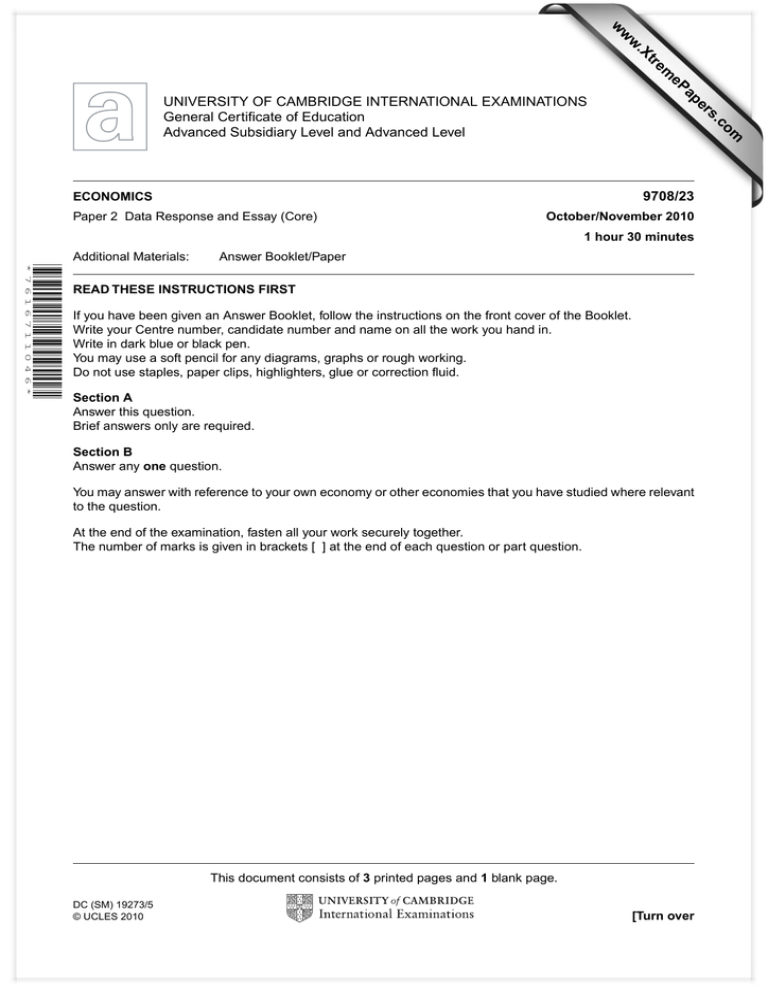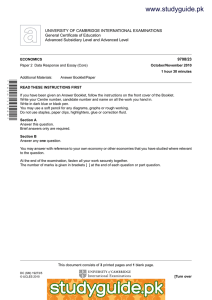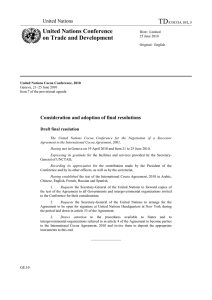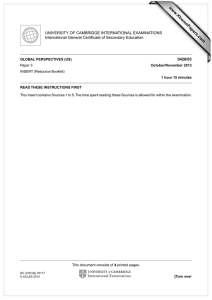www.XtremePapers.com
advertisement

w w ap eP m e tr .X w om .c s er UNIVERSITY OF CAMBRIDGE INTERNATIONAL EXAMINATIONS General Certificate of Education Advanced Subsidiary Level and Advanced Level 9708/23 ECONOMICS Paper 2 Data Response and Essay (Core) October/November 2010 1 hour 30 minutes Additional Materials: Answer Booklet/Paper *7616711046* READ THESE INSTRUCTIONS FIRST If you have been given an Answer Booklet, follow the instructions on the front cover of the Booklet. Write your Centre number, candidate number and name on all the work you hand in. Write in dark blue or black pen. You may use a soft pencil for any diagrams, graphs or rough working. Do not use staples, paper clips, highlighters, glue or correction fluid. Section A Answer this question. Brief answers only are required. Section B Answer any one question. You may answer with reference to your own economy or other economies that you have studied where relevant to the question. At the end of the examination, fasten all your work securely together. The number of marks is given in brackets [ ] at the end of each question or part question. This document consists of 3 printed pages and 1 blank page. DC (SM) 19273/5 © UCLES 2010 [Turn over 2 Section A Answer this question. 1 Ghanaian Cocoa and Cadbury’s Chocolate In January 2008 Cadbury Schweppes, one of the largest multi-national confectionery producers, was facing problems. The price of its raw materials had reached record levels and consumers were being given government health warnings about the link between eating chocolate and being overweight. Cocoa is one of the main ingredients in chocolate. Ghana provides Cadbury with 70% of its cocoa needs and Cadbury buys 10% of Ghana’s total cocoa output. In January 2008, Ghana’s cocoa sold at $2557 per tonne, 10% above the average world price. A study found that in 2008 the average production of a cocoa farmer in Ghana had dropped to 40% of potential yield and that the children of cocoa farmers did not want to work in the family business, where annual income was as little as $850. Content removed due to copyright restrictions To improve matters Cadbury established the Cadbury Cocoa Partnership in 2008, providing $87m over ten years to help cocoa farmers. The purpose of the partnership was to show cocoa farmers how to use fertilisers and work together. It also hoped to introduce new crops by encouraging the growing of red peppers, mangoes and coconuts, which can grow alongside cocoa trees. As well as this, Cadbury ordered the construction of 850 wells, each of which will provide water for about 200 people. This should enable women and children to reduce the time spent fetching water. Table 1 World cocoa output showing the main producing countries Producer 2002/3 (000 tonnes) 2006/7 (000 tonnes) 160 166 1352 1229 Ghana 497 615 Indonesia 410 520 Nigeria 173 190 World 3169 3376 Cameroon Cote d’Ivoire (a) Suggest the likely opportunity cost to Ghanaian children of time spent fetching water. Explain your answer. [2] (b) Use Table 1 to compare the change in Ghana’s cocoa output with that of the other main producers. [3] (c) With the use of a diagram, analyse the effect on the market for Cadbury’s chocolate of the problems reported in the first paragraph. [6] (d) Explain how the Cadbury Cocoa Partnership hoped to affect the productivity of cocoa farmers. [3] (e) Discuss the consequences for countries such as Cote d’Ivoire and Ghana of relying heavily on the production of one crop. [6] © UCLES 2010 9708/23/O/N/10 3 Section B Answer one question. 2 (a) Explain the difficulties of carrying out a cost-benefit analysis. [8] (b) Discuss the economic consequences of externalities associated with production and consumption. [12] 3 (a) Explain why a low and stable rate of inflation may be beneficial to an economy. (b) Discuss whether rapid inflation can be caused only by government actions. 4 [8] [12] (a) Explain (i) the difference between trade creation and trade diversion, and (ii) the difference between expenditure-dampening and expenditure-switching trade policies. [8] (b) Discuss whether a balance of payments current account deficit necessarily indicates a weak economy. [12] © UCLES 2010 9708/23/O/N/10 4 BLANK PAGE Copyright Acknowledgements: Question 1 Text Question 1 Table © Fair Enough ; 2 February 2008; The Economist. © Quarterly Forecast of Product and Consumption 2012/13 ; International Cocoa Organisation. Permission to reproduce items where third-party owned material protected by copyright is included has been sought and cleared where possible. Every reasonable effort has been made by the publisher (UCLES) to trace copyright holders, but if any items requiring clearance have unwittingly been included, the publisher will be pleased to make amends at the earliest possible opportunity. University of Cambridge International Examinations is part of the Cambridge Assessment Group. Cambridge Assessment is the brand name of University of Cambridge Local Examinations Syndicate (UCLES), which is itself a department of the University of Cambridge. © UCLES 2010 9708/23/O/N/10




